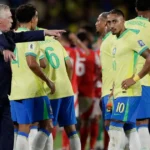The Argentina national football team, often hailed as one of the most storied sides in the beautiful game, embodies the fiery spirit of a nation where football isn’t just a sport—it’s a religion. Known affectionately as La Albiceleste for their iconic light blue and white striped jerseys, this team has captivated the world with its blend of technical brilliance, dramatic flair, and unyielding determination. From the dusty pitches of early 20th-century Buenos Aires to the glittering stages of global tournaments, the Argentina football team has scripted tales of triumph and heartbreak that resonate with millions. Whether you’re a die-hard fan or a newcomer drawn in by the magic of Lionel Messi, diving into the world of Argentine football is like stepping into a passionate tango—intense, rhythmic, and utterly mesmerizing.
In this comprehensive guide, we’ll explore the rich tapestry of the Argentina national football team’s journey. From its humble beginnings to its current status as a powerhouse, we’ll cover the team’s history, major achievements, legendary key players, tactical evolutions, recent results, upcoming fixtures, vibrant fan culture, and a forward-looking outlook. If you’ve ever wondered about the Argentina FIFA ranking or caught yourself searching for details on the Argentina next match, you’re in the right place. Let’s kick off this adventure with a look back at where it all began.
A Storied History: From Pioneer to Powerhouse
The Argentina football team didn’t just emerge overnight; its roots trace back to the dawn of organized international football in South America. The team’s inaugural match took place on July 20, 1902, against Uruguay in Montevideo—a resounding 6-0 victory that set the tone for what would become a fierce rivalry. This game wasn’t just a sporting event; it was a milestone for a young nation forging its identity through the sport.
In the early 1900s, Argentina was a pioneer in regional competitions. They dominated the South American Championship (now known as Copa América), winning the first edition in 1921 and securing 15 titles overall, more than any other nation. These triumphs weren’t without challenges—long travel times across the continent and the disruptions of World War I limited their international exposure. Yet, the team thrived domestically, using venues like the GEBA Stadium in Buenos Aires, where they first donned the light blue and white stripes on September 13, 1908, during a match against Uruguay. That jersey design, inspired by a local rowing club’s colors, has since become synonymous with Argentine pride.
The mid-20th century brought global ambitions. Argentina’s debut at the 1930 FIFA World Cup in Uruguay ended in heartbreak—they reached the final but lost 4-2 to the hosts amid controversy over home advantage and rough play. Undeterred, the team bounced back with silver medals in 1934 and 1950, showcasing the resilience that defines them. The 1950s and 1960s saw a golden era of South American dominance, with stars like Alfredo Di Stéfano leading charges in Copa América wins in 1941, 1945, 1946, 1947, 1955, 1957, and 1959. Di Stéfano, though more famed for his Real Madrid exploits, was a cornerstone in building Argentina’s technical pedigree.
The 1970s marked a turning point. Hosting the 1978 World Cup, Argentina lifted their first Jules Rimet trophy under coach César Luis Menotti. Mario Kempes emerged as the tournament’s top scorer with six goals, including a brace in the final against the Netherlands. This victory, amid political turmoil in the country, united a divided nation and solidified football’s role as a social glue. The 1980s brought even more drama: the 1986 World Cup in Mexico, where Diego Maradona’s genius—infamous “Hand of God” and the “Goal of the Century” against England—propelled them to a second title under Carlos Bilardo.
The 1990s and 2000s were a rollercoaster of near-misses. Runners-up in 1990, quarter-final exits in 1998 and 2006, and a heartbreaking penalty shootout loss to Germany in 2010 tested the team’s mettle. Yet, these eras produced icons and honed a style of play that blended European discipline with South American flair. Entering the 2010s, with Lionel Messi donning the captain’s armband, Argentina chased redemption. Final losses in the 2014 World Cup and three consecutive Copa Américas (2015, 2016, 2019) fueled narratives of a “cursed” generation. But as we’ll see, curses are made to be broken.
This historical arc isn’t just about wins and losses; it’s about a team that mirrors Argentina’s soul—passionate, unpredictable, and profoundly human. The Argentina football team has played over 700 official matches, scoring more than 1,500 goals, and their journey continues to inspire young talents in the barrios of Buenos Aires and beyond.
Major Achievements: Trophies That Echo Through Generations
When it comes to silverware, few teams can match the Argentina national football team’s haul. With 23 official senior titles as of 2025—the most in men’s international football—they stand as CONMEBOL’s undisputed kings. Their trophy cabinet is a testament to sustained excellence across eras.
At the pinnacle sits the FIFA World Cup, with three conquests: 1978, 1986, and the emotional 2022 triumph in Qatar. That 2022 victory, a 3-3 penalty shootout win over France after extra time, wasn’t just a title; it was Messi’s crowning glory, ending a 36-year drought and etching the team into immortality. Individually, Argentine players have shone brightly: Guillermo Stábile (1930) and Kempes (1978) as top scorers, and Maradona (1986), Messi (2014, 2022) claiming the Golden Ball for best player.
Copa América? They’re the masters with 16 wins (1921, 1925, 1927, 1929, 1937, 1941, 1945–47, 1955, 1957, 1959, 1991, 1993, 2021, 2024). The 2021 and 2024 editions, both under Lionel Scaloni, bookended Messi’s international redemption arc. Add the inaugural 1992 FIFA Confederations Cup, two CONMEBOL–UEFA Cups of Champions (1993, 2022), and the 1960 Panamerican Championship, and you’ve got a resume that screams dominance.
These achievements aren’t isolated; they’re woven into cultural fabric. The 1978 win sparked nationwide celebrations, while 2022’s streets of Buenos Aires became seas of blue and white. For fans tracking the Argentina FIFA ranking, these hauls explain their perennial top-five status—currently at No. 2 as of October 2025, just behind Spain after a brief dip from their post-2022 reign at the summit.
To better understand this legacy, here’s a concise table of the Argentina football team’s major achievements:
| Competition | Titles Won | Years Won | Notable Highlights |
|---|---|---|---|
| FIFA World Cup | 3 | 1978, 1986, 2022 | Messi’s 2022 Golden Ball; Maradona’s 1986 magic |
| Copa América | 16 | 1921, 1925, 1927, 1929, 1937, 1941, 1945–1947, 1955, 1957, 1959, 1991, 1993, 2021, 2024 | Most successful team ever; Messi’s first major trophy in 2021 |
| FIFA Confederations Cup | 1 | 1992 | Inaugural winners under Alfio Basile |
| CONMEBOL–UEFA Cup of Champions | 2 | 1993, 2022 | Beat Brazil (1993) and Italy (2022) |
| Panamerican Championship | 1 | 1960 | Early regional dominance |
This table highlights not just the quantity but the quality of their successes, making it easier to grasp why the Argentina football team remains a benchmark for excellence.
Key Players: Icons Who Defined an Era
No discussion of the Argentina national football team is complete without its luminaries. These aren’t just players; they’re poets of the pitch, turning games into art.
Lionel Messi, the maestro, holds records as the most-capped (194 appearances) and highest scorer (114 goals) for Argentina as of November 2025. His 2022 World Cup heroics—seven goals, three assists—silenced critics, while his eight Ballon d’Ors underscore his genius. At 38, Messi’s vision and free-kick wizardry remain vital.
Diego Maradona, the eternal rebel, defined the 1980s with his 1986 World Cup triumph. His five-goal haul against England, including the controversial handball and solo masterpiece, is folklore. Off the field, his charisma made him a god-like figure.
Earlier legends include Alfredo Di Stéfano, the “Blond Arrow,” whose elegance won six European Cups with Real Madrid and fueled Argentina’s 1940s Copa streak. Mario Kempes, the 1978 hero, scored decisive goals with predatory instinct. Ángel Di María, still active at 37, brings tireless wing play—his 2021 Copa final goal was pure poetry.
The current squad boasts depth: Emiliano “Dibu” Martínez’s penalty-saving heroics in shootouts, Lautaro Martínez’s clinical finishing (25 goals in 50 caps), Enzo Fernández’s midfield metronomy, and Julián Álvarez’s explosive youth. Emerging stars like Franco Mastantuono, who debuted at 17 in 2025, signal a seamless transition.
These players aren’t mere athletes; they embody garra charrúa-like grit mixed with pibe de oro flair, making every Argentina next match a potential classic.
Tactics: The Evolution of La Albiceleste’s Style
The Argentina football team’s tactics have evolved like a fine Malbec—complex, bold, and ever-adapting. Early days favored fluid, attacking la nuestra—a creative, dribble-heavy style emphasizing individual brilliance over rigid systems.
César Luis Menotti’s 1978 side introduced a 4-3-3 with high pressing, blending attack and defense seamlessly. Bilardo’s 1986 team shifted to a pragmatic 3-5-2, prioritizing Maradona’s freedom amid a defensive shell. The 1990s under Alfio Basile leaned on counter-attacks, but inconsistencies led to experimentation.
Lionel Scaloni’s era, since 2018, marks a modern renaissance. His preferred 4-3-3 morphs into a 3-5-2 defensively, with full-backs like Nahuel Molina overlapping aggressively. Midfield pivots like Rodrigo De Paul and Enzo Fernández provide balance, allowing Messi to roam as a false nine or right-winger. The emphasis? Positional fluidity, high possession (often 60%+), and set-piece lethality—Martínez’s saves in big moments are tactical gold.
This adaptability—attacking verve against weaker foes, resilience in knockouts—has yielded trophies. As they eye 2026, Scaloni’s hybrid model, blending youth and experience, keeps the Argentina FIFA ranking elite.
Recent Results: Building Momentum Toward 2026
The Argentina national football team’s 2025 has been a masterclass in dominance, blending World Cup qualifiers with friendlies to fine-tune for defense of the crown. Already the first qualifiers for 2026 after topping CONMEBOL standings, they’ve notched 11 wins in 16 qualifiers.
Key 2025 highlights include a 5-0 thrashing of Bolivia in qualifiers, where Messi dazzled with a quintet of assists. A 2-0 win over Venezuela on September 9 at Estadio Monumental showcased youth integration, with Álvarez netting twice. October friendlies in the US—against China and a yet-to-be-confirmed Asian powerhouse like Japan—served as low-stakes tests, yielding comfortable victories and tactical tweaks.
The year’s crescendo? A 2-0 friendly triumph over Angola on November 14 in Luanda, capping 2025 unbeaten. Messi scored his first African goal for the national team and assisted Lautaro Martínez, tying his assist record for a teammate. This result, amid Angola’s independence celebrations, underscored Argentina’s global pull.
With minimal losses (none in 2025 internationals), these performances affirm their No. 2 Argentina FIFA ranking, setting a high bar for the World Cup draw on December 5, 2025.
Upcoming Fixtures: Eyes on the Horizon
Excitement brews for the Argentina next match as 2026 looms. Post-Angola, the calendar quiets until March 2026, when La Finalissima against Spain beckons—a rematch of 2022’s UEFA-CONMEBOL clash, likely in a neutral venue.
World Cup prep ramps up with friendlies in late March or June 2026, possibly against European heavyweights. Hosted across the US, Canada, and Mexico, Argentina’s group-stage opener could be mid-June in a US stadium, pitting them against diverse foes per the December draw.
Tracking the Argentina next match is essential; qualifiers are done, but these tune-ups will blend veterans like Messi with prodigies like Mastantuono. Fans, mark your calendars—glory awaits.
Fan Culture: The Heartbeat of La Albiceleste
Argentine football fandom is visceral, a symphony of chants, flares, and unbridled joy. Supporters, or hinchas, turn matches into carnivals: the barra brava—passionate ultras—lead deafening renditions of “Muchachos” at Monumental Stadium, the spiritual home since 1978.
Rivalries ignite the soul—Superclásico vibes extend to Brazil (Clásico de la Rivalidad) and Uruguay. Yet, unity prevails: 2022’s World Cup saw Buenos Aires’ Obelisk become a blue-white sea, with millions dancing till dawn. Globally, diaspora communities in Europe and the US amplify this fervor, creating pockets of passion.
Fan culture transcends games; it’s social commentary, protest, and celebration. From murals honoring Maradona to Messi’s statue unveilings, it’s a living testament to why the Argentina football team pulses with life.
Future Outlook: Defending the Crown and Beyond
As 2026 nears, the Argentina national football team’s future gleams. Scaloni’s contract runs through the World Cup, with Messi hinting at a farewell tilt at 39. Depth abounds: Álvarez’s Manchester City form, Fernández’s Chelsea poise, and talents like Alejandro Garnacho promise continuity.
Challenges? Integrating youth without disrupting harmony, navigating a loaded World Cup (48 teams), and maintaining the Argentina FIFA ranking amid Spain’s rise. Yet, with 23 titles and a winning culture, they’re primed. A fourth star? Likely. A dynasty? Inevitable.
In wrapping up, the Argentina football team isn’t just about trophies—it’s about evoking tears, cheers, and that electric thrill of possibility. As we await the Argentina next match, one thing’s certain: La Albiceleste will dance on, inspiring generations. What’s your favorite memory? Share in the comments—vamos Argentina!






